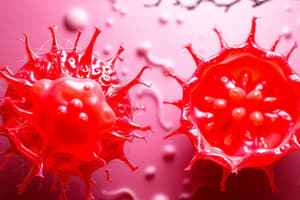Podcast
Questions and Answers
What is the primary cause of hypertrophy in cells?
What is the primary cause of hypertrophy in cells?
- Increased protein synthesis (correct)
- Aging
- Nutritional deficiency
- Decreased workload
What characterizes atrophy in cellular adaptation?
What characterizes atrophy in cellular adaptation?
- Decrease in cell size (correct)
- Increase in the number of cells
- Replacement of one tissue by another
- Increase in cell size
Which condition is an example of physiological hyperplasia?
Which condition is an example of physiological hyperplasia?
- Chronic inflammation of tissues
- Increased muscle mass from exercise
- Endometrial hyperplasia
- Enlargement of the breast during pregnancy (correct)
In which cellular adaptation do differentiated tissues replace one another?
In which cellular adaptation do differentiated tissues replace one another?
What is a potential consequence of dysplasia?
What is a potential consequence of dysplasia?
Which of the following can lead to atrophy of cells?
Which of the following can lead to atrophy of cells?
What type of metaplasia is seen in smokers' lungs?
What type of metaplasia is seen in smokers' lungs?
Which of the following does NOT describe hypertrophy?
Which of the following does NOT describe hypertrophy?
Flashcards
Hypertrophy
Hypertrophy
Increase in the size of cells.
Atrophy
Atrophy
Decrease in the size of cells.
Hyperplasia
Hyperplasia
Increase in the number of cells.
Metaplasia
Metaplasia
Signup and view all the flashcards
Squamous metaplasia
Squamous metaplasia
Signup and view all the flashcards
Osseous metaplasia
Osseous metaplasia
Signup and view all the flashcards
Dysplasia
Dysplasia
Signup and view all the flashcards
Cellular adaptation
Cellular adaptation
Signup and view all the flashcards
Study Notes
Cellular Adaptations
- Cellular adaptations are changes cells undergo in response to environmental stimuli.
- Major types include hypertrophy, atrophy, hyperplasia, metaplasia.
- Hypertrophy: Increase in cell size.
- This is driven by increased workload.
- Leads to increased protein synthesis and intracellular organelle size.
- Resulting increased cell size causes increased organ size.
- Examples include enlarged left ventricle (hypertensive heart disease) and skeletal muscle growth with exercise.
- Atrophy: Decrease in cell size.
- Can be caused by factors like disuse, undernutrition, decreased endocrine stimulation, denervation, or old age.
- Associated with muscle cell loss in inactivity and aging.
- Causes a decrease in organ size.
- Hyperplasia: Increase in cell number.
- Often linked to hormonal stimulation or increased workload.
- Results in increased organ size.
- Examples include breast enlargement during pregnancy and endometrial hyperplasia.
- Metaplasia: Replacement of one differentiated cell type with another.
- Columnar epithelium can transition to squamous epithelium in smokers' lungs.
- Connective tissue can turn into bone at injury sites.
- Illustrates cells' adaptability to changing conditions.
- Dysplasia: Abnormal changes in cell size, shape, and organization.
- Though not cancer, it can develop into cancer.
- Severity varies (mild, moderate, severe), based on microscope findings.
- Impacts tissue and organ in affected areas.
Studying That Suits You
Use AI to generate personalized quizzes and flashcards to suit your learning preferences.




